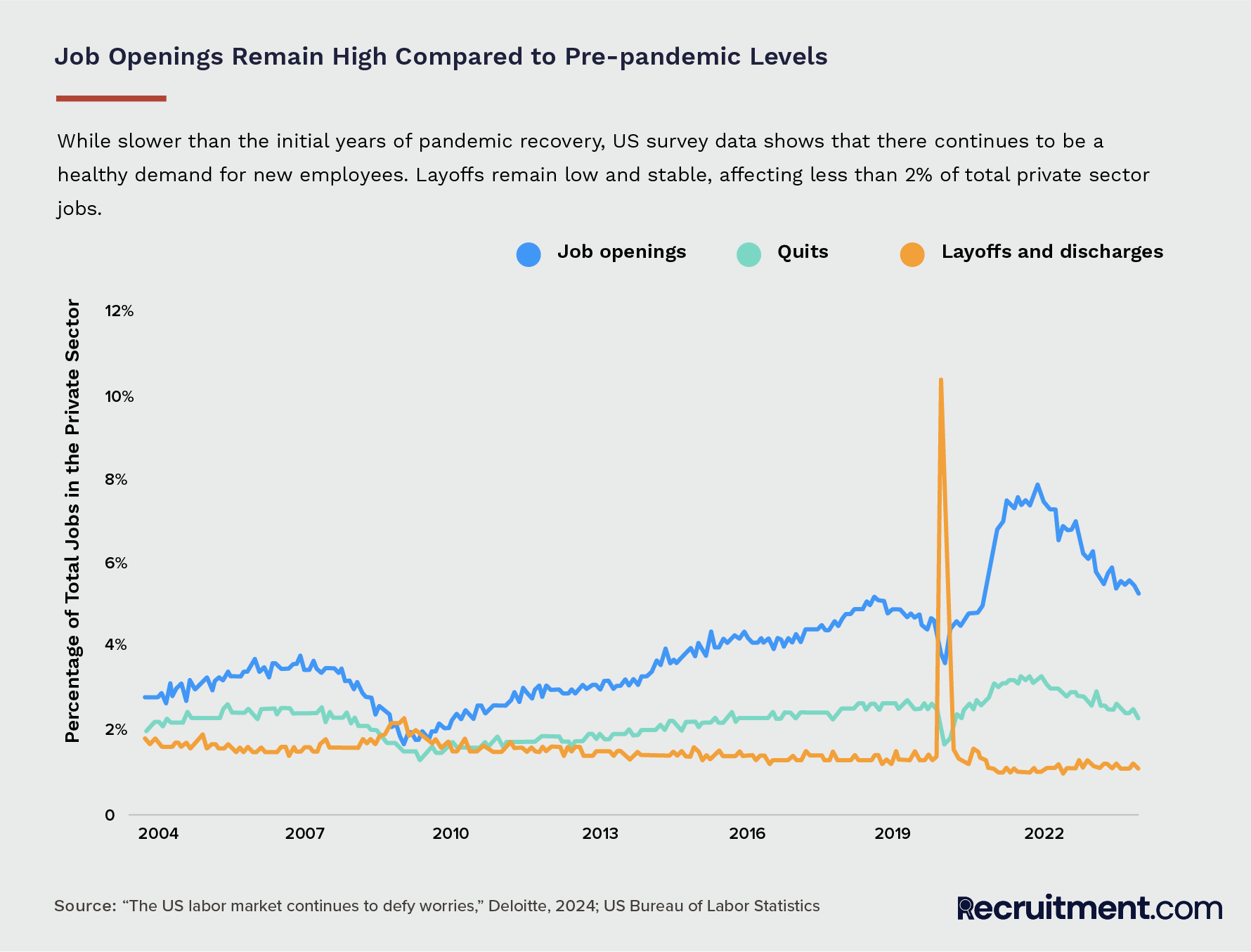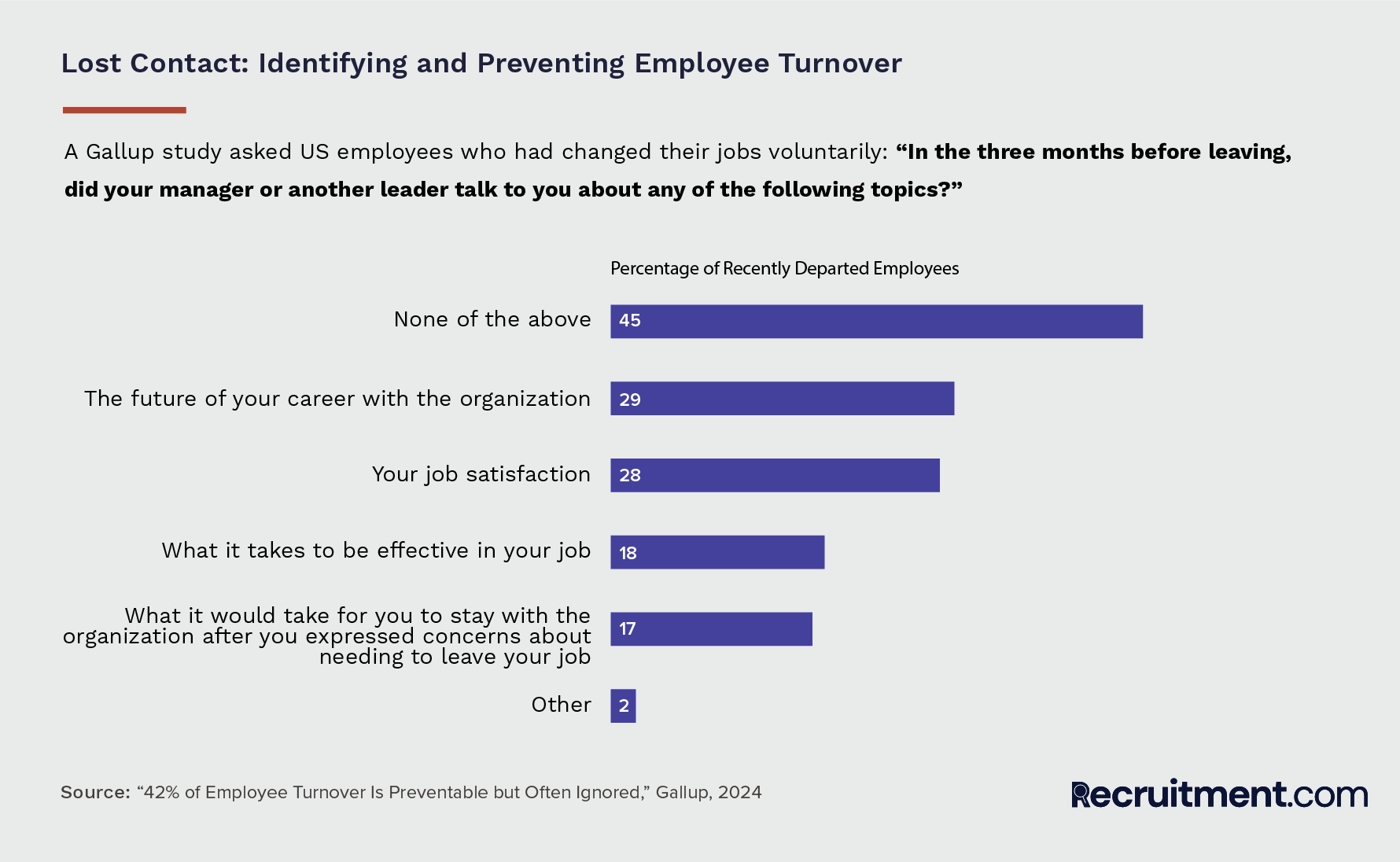Building a Resilient Recruitment Culture: Keys to Retention in a Changing Landscape

Samantha Perlman, Head of People at OneSignal, has 10+ years in recruitment, including roles at Airbnb and Fastly. She's co-founder/CEO of 1Up Events and an executive member of the HIGHER Community, a global network of talent acquisition leaders.
Retaining top recruiters is essential for building a strong talent pipeline. Here are six key strategies to keep your recruiting team engaged and motivated.
As talent leaders, retaining recruiters must be a top priority. Why? Because recruiters are the architects of your company’s foundation, identifying and attracting the talent that fuels growth. When they’re dissatisfied, it’s not just their well-being on the line—it’s your organization’s future.
Throughout my career as a recruiter and talent leader, I’ve gained valuable insights into the uniquely human aspects of the role. As recruiters, we work with different people day in and day out—candidates, hiring teams, our own teams—and play a critical role in their success. Integrating recruiting with broader HR functions like onboarding, learning and development (L&D), performance management, and employee relations helps recruiters be better partners and advisors. During my time as Head of Talent at OneSignal, I put this philosophy front and center, enabling my recruiters to think critically about candidates’ long-term potential so they could thrive as strategic partners to their hiring teams.
I was recently promoted to Head of People at OneSignal, meaning I now lead both Talent and HR. My new role reflects an industry shift where more and more HR leaders are coming from TA backgrounds instead of HR backgrounds, helping better bridge the gap between the candidate experience and employee experience, while also integrating strategic hiring with thoughtful organizational design. This alignment empowers recruiters to engage with hiring managers on team performance and culture, helping identify the skills and traits necessary for long-term success.
Transparency is essential in setting candidates up for success. At OneSignal, open discussions about the fast-paced and evolving startup environment help candidates make informed choices, leading to stronger, more aligned hires. Beyond hiring, recruiters also act as career advisors, guiding candidates on whether a role aligns with their growth goals. Looping recruiters into performance review calibration sessions gives them greater insight into how the skills and qualities they’ve indexed on in the hiring process have served the candidate as an employee in the role. This allows them to adjust the hiring process if needed, refine onboarding, and ensure roles are accurately represented.
Caring for your recruiting team is like putting on your own oxygen mask first—you need to support your team before you can focus on the rest of the organization. While the job market has shown signs of stabilizing—with the US economy adding 254,000 jobs in September 2024, exceeding the median forecast, according to the US Bureau of Labor Statistics—uncertainty remains. Mass layoffs continue to impact industries such as tech, banking, education, and healthcare, leaving many employees understandably anxious in the face of ongoing instability.
Drawing on my experience as both a recruiter and talent leader, I’ve developed practical strategies to help keep your team engaged, motivated, and committed for the long haul. In times of uncertainty, employees often need extra support to stay focused and connected. Addressing these challenges proactively can make all the difference when it comes to retaining top talent and building a resilient team.

Have Regular Check-ins
Keeping a pulse on your department’s morale is essential. We’ve introduced AMAs through Slido and use Officevibe, a tool for gathering anonymous pulse checks. It helps me understand how employees feel—both across the company and within specific departments. I also rely heavily on ad hoc check-ins with my team, asking questions like, “What’s going on in your world? What’s keeping you motivated? What’s frustrating you right now?”
I make a point to check in on their workload and see how they’re faring. Because recruiting workloads fluctuate month to month, I ask my recruiters if they're interested in taking on additional projects, given the current state of their req load and the status of their pipelines. If they are, I look for opportunities that align with their passions and that they can get excited about. This proactive approach can prevent employee turnover, which, according to a recent Gallup survey, is often avoidable—42% of U.S. employees who quit reported their departure could have been prevented with better communication and support.
At least twice a year, we do a brainstorming session about what additional projects we want to take on. One of those project ideas was to start a new-hire Linkedin post. And it was the perfect chance to give project ownership of that to the team member most excited about it. Providing these opportunities is essential—not only to keep employees engaged but also to help them build skills beyond recruiting, and to serve them well in not only their current role, but to make them even more valuable to your company and further them in any future role they may choose to take in their career.
Just as important as offering growth opportunities is making sure the team understands the broader impact of their work. In team meetings, we make a point to highlight how their efforts contribute to the company’s success and the tangible ways they’ve helped the business grow. Celebrating these wins helps to keep my team motivated, especially when they see the accomplishments of their new hires recognized in our Slack kudos channels. These moments of recognition and reflection can be just as energizing as taking on a new project.
Foster a Supportive and Transparent Environment
Effective communication is essential to successful recruiting leadership. Transparency, removing roadblocks, and providing the necessary resources are essential for ensuring job satisfaction and retention. Regular check-ins and open conversations about headcount and future plans foster trust and build resilience. And for recruiters, resilience is crucial. In a recruiting role, one thing is certain: the job market is always evolving. Navigating these shifts requires the ability to adapt, and that adaptability begins with trust—in both your team and your leadership.
One way I build trust as a leader is by leading with empathy. I trust my team to deliver because I know how self-motivated they are. At the same time, I recognize they’re human—things like doctor’s appointments, family matters, and errands come up. They know they have the flexibility to handle personal matters when needed, and I’m here to support them. All I ask is that they keep their calendars up to date so stakeholders know when they’re unavailable, and that they reach out to me or teammates for any necessary coverage while they’re away. I’ve found that when you give recruiters a roof, they usually rise to meet you.

If your team is remote, like mine, creating a supportive workplace environment becomes more complex. To maintain a sense of community, I organize casual Zoom sessions where team members can work together while chatting about personal topics—whether it’s weekend plans or the latest TV shows. Without the organic interactions of hallway conversations or office kitchen small talk, remote work can feel isolating. That’s why these sessions are so important—they foster connection and help prevent disengagement. It also helps that I genuinely love my team and enjoy spending time with them.
Get Ahead of Layoffs and Bring Receipts
Recognizing the versatility of recruiters is key to unlocking their potential beyond hiring roles. At OneSignal, I developed an internal document called “Reallocating Recruiters” that outlines the diverse skills recruiters bring and where they could transition during hiring slowdowns, freezes or reductions in force. Potential roles span departments like sales, marketing, finance, operations, customer experience, and HR. This tool ensures we recognize their value and identify opportunities within the company.
Nearly two years ago, I was told we were going to pre-emptively slow down hiring, and thus I needed to reduce the size of my recruiting team. While slowing down made sense to avoid over-hiring in a volatile economy, laying off a team member would be shortsighted. Recruiters are accustomed to navigating hiring freezes and slow periods and know that hiring needs can quickly ramp back up. Letting someone go, disrupting their life, and then needing to rehire months later would be counterproductive.
Fortunately, one of my recruiters was able to transition into an open sales development representative role, which leveraged similar skills such as strong communication, unwavering grit, time management, and experience with related tools. I made the case to the sales team, emphasizing that this employee was already familiar with the company and our value prop, had strong cross-functional relationships, was the ultimate embodiment of our culture, and demonstrated clear value. “Why risk hiring and training someone new when you have a known entity who would need limited ramp time?” The transition was successful, underscoring that hiring new talent based on potential is inherently riskier than capitalizing on the track record of a tenured employee.
I’m well aware that not all companies have the flexibility to offer internal mobility and reassign employees. Meta, for example, laid off around 10,000 employees earlier this year, including thousands of recruiters. Finding new roles internally for that many people just isn’t feasible and would defeat the point of them needing to cut costs. But, if your company is doing well financially and you need to minimally downsize your team in preparation for a hiring slow, you may have the opportunity to move them within the company.
Reallocating employees like this is a win for everyone. Finance appreciates the approach because it saves money on ramping a new hire, the new manager appreciates it because it removes risk, and you maintain the morale of your team because it shows the versatility of recruiters. It’s unfortunately all too common for higher ups to think, “Well, if we’re not hiring, then we should be getting rid of our hiring teams.” But that’s just wrong. In addition to the fact that you’ll always have some natural attrition and need recruiters to cover backfills, recruiters can provide so much value beyond their daily responsibilities. And it’s on us, as leaders, to communicate that to the rest of our exec team.
Educate the Company About What Recruiters Really Do
Recruiters do far more than just hire people. During slower periods, recruiters can shift focus to critical work they rarely have time for during hiring surges. This “backlog” of projects is essential to long-term success and ensures smoother operations when business inevitably picks up again.
Much like tech debt, recruiters accumulate process improvements—systems they want to refine but can’t always prioritize when the number one priority is hiring. Tasks like refining interview questions, ensuring they remain relevant and interesting for candidates, and building out interview assessment rubrics, can often fall by the wayside. These activities are crucial to creating an optimized candidate experience beyond hiring alone.
By educating the company on these hidden aspects of recruiting, leaders can see the value recruiters bring, even during slower periods. It positions recruiters not as a function to be downsized but as a strategic asset, continuously improving processes to meet future demands.

Create Networking Opportunities
Giving your team meaningful exposure to key people in the company is important. Whenever an opportunity arises for one of my recruiters to engage with senior staff, I make sure they’re included. It’s a chance for them to gain valuable facetime and build relationships they might not otherwise have access to.
For example, I’m in the process of developing a company-wide training program at OneSignal. I have a team member who has shown interest in this project, so they’ll be involved in the planning process, and help me launch and deliver the training sessions. This will give them increased visibility across the company.
By bringing team members into meetings, presentations, or cross-department projects, we can help our recruiters build relationships, demonstrate their strengths, and stay top of mind when new roles or promotions arise. Without these chances, talented team members might remain unseen by key decision-makers.
Leverage Technology to Reduce Burnout
Burnout is a major challenge these days. Now smaller than ever, recruiting teams are expected to handle just as much work, if not more, as many roles receive 100+ applications daily. Luckily, technology plays a key role in reducing this strain by automating repetitive tasks that aren’t the best use of recruiters' time.
For example, the scheduling tool ModernLoop costs far less than hiring a recruiting coordinator, while still lightening the team’s load. Similarly, Gem automates outreach with drip campaigns, eliminating the need to manually follow up on candidate emails. Its visual pipeline tracking is a game-changer—I’m definitely dating myself here, but I used to track my pipelines with sticky notes on a whiteboard back in the pre-Trello or reasonable ATS days—and it provides valuable diversity metrics to monitor candidate pools.
I’m excited to further explore this new wave of recruiting AI tools. Each manual administrative task shifted to technology allows my team to stay focused on critical thinking and quintessentially human elements while also preventing burnout.
Build Resilience, Drive Success
From reallocating recruiters into other roles to creating meaningful opportunities for them, I hope my strategies can help you empower your teams to thrive. When recruiters feel supported and connected, they become more adaptable, engaged, and ready for what’s next. Investing in their well-being and development helps you retain top talent and ensures your organization is prepared for future challenges. Resilient recruiters build resilient companies, and when you prioritize their growth, success will follow.

Samantha Perlman, Head of People at OneSignal, has 10+ years in recruitment, including roles at Airbnb and Fastly. She's co-founder/CEO of 1Up Events and an executive member of the HIGHER Community, a global network of talent acquisition leaders.
